|
The Puma as built by Rossi in
Brazil has been around for many years now, and is a pretty
faithful copy of the Model 1892 Winchester lever action
rifle. More commonly called the Model 92, that wonderful rifle
was surely inspired by God and designed by John Browning
for Winchester back in late 1890, being basically a scaled down
Model 1886, which is also a superb, but larger, levergun.
The design was to be a great improvement in strength and
durability over Winchesterís Model 1873. The 92 was one of the
most successful leverguns ever sold by Winchester, and their
ceasing production after about one million rifles and fifty
years of production left a void that went unfilled for many
years. Since the end of production of the Model 92, it has been
left to producers in countries outside of the United States to
meet the demand for these excellent little rifles and carbines,
the most prolific of which has been Rossi of Brazil.
Rossi has built the Model 92 with varying
degrees of quality over the past three decades or so, with the
latest ones being some of the best to date. Imported by a
couple of different importers, the Rossi-built leverguns are as
popular as ever. A few years ago, Legacy Sports International
started advertising that they were importing a Rossi Puma
built to handle the .454 Casull cartridge. Most everyone,
including me, was skeptical that the little carbine could handle
such pressures, as conversions had been tried before, with
disappointing results. A little over four years ago, Paco
Kelly was also skeptical, but decided to try one for
himself. He was so impressed with the .454 Puma that he wrote a review
for Gunblast, which was published in December of 2002,
and is in our ARCHIVE section.
I recommend that you read that also. Legacy had enough changes
made to the weapon that they hold up really well, with no
shearing of the magazine retaining screw as can happen on the
Model 92 when converted to handle the heavily-recoiling
cartridges, such as the .454 Casull.
[Ed. Note: From subsequent conversations I
have had with Paco, he remains as impressed as ever with the
Puma .454. There have been no failures or problems of any kind
after digesting thousands of Paco's hot handloads. - Boge Quinn]
The levergun featured in this review is
basically the same as the .454, except that it is chambered for
the .480 Ruger cartridge. The rifle tested here is the
stainless steel model with the twenty inch round barrel and an
overall length of just thirty-eight inches. The barrel has
a gentle taper, and with the huge bore, is nicely light and
trim. The rifle balances beautifully, and weighing just one
ounce over six pounds, is a dream to carry afield. The balance
point is exactly at the barrel/receiver junction when empty, and
the rifle is quick to shoulder and handles like it is even
lighter. The stainless finish looks good with the walnut-stained
hardwood stock. The action is the same trim Model 92 that
chambers the smaller cartridges such as the .357 and .44
magnums, with minor but important changes made to accommodate
the larger .480 Ruger cartridge. The magazine tube is threaded
into the receiver, instead of just held in with a retainer
screw, solving the problem of the tube coming loose as can
happen when a standard 92 is converted to a larger caliber.
Also, the magazine tube is unique to the .454 and .480 Pumas in
that it has an internal tube that can be unscrewed from the
outer tube, withdrawn, and loaded like loading a tubular
magazine on a rimfire rifle. This is a handy feature, but I
prefer loading through the loading gate on the right side of the
receiver as with most lever action rifles. The removable tube
does allow another option however, and is a very handy feature
for quickly unloading the carbine without cycling the ammunition
through the action. Loading by withdrawing the tube, nine rounds
would fill the tube up to the port. Chambering one would allow a
total of ten rounds to be carried. However, when loading as
normally done through the loading gate in the receiver, ten
rounds could be loaded. Chambering one then allowed another to
be inserted through the gate, for a total capacity of eleven of
the big .480 Ruger cartridges. That is a lot of firepower in
such a compact carbine.
The Puma tested here wears the optional Hi-Viz
fiber optic sights that are very easy to see in low light
conditions such as in the deep woods or at sunrise/sunset. Both
front and rear are set into dovetails in the barrel, and the
rear is adjustable for windage and elevation correction. They
are a good option on a hunting rifle, and much easier to use
quickly that a plain black post front sight with a rear notch.
The buttstock wears a very effective recoil pad, which is a
welcome feature on a light rifle chambered for such a powerful
cartridge. The action uses a coil hammer spring, but was
still very smooth to operate, as slick as any Puma that I have
ever handled. The trigger pull measured two and three-quarters
pounds, which is about perfect on such a rifle. I was pleasantly
surprised to find such an excellent trigger on a modern-day
levergun.
The .480 Ruger
cartridge, though relatively new, has been with us for a
few years now. It was developed by Ruger and Hornady
as a very powerful big bore revolver
cartridge, and I am glad to see that Legacy has
introduced it into the Puma rifle. The cartridge is very well
suited to the action length of a Model 92, and all loads tested,
from the lightest hollowpoint bullets to the longest, heaviest
cast lead blunt-nosed slugs, worked beautifully through the
Puma. Even the long Belt
Mountain Punch bullets, seated to the middle crimping
groove, fed perfectly.
I tested the Puma with a variety of factory and
handloaded ammunition. The handloads were developed in both Starline
and Hornady cases, and used Winchester Magnum Large Pistol
primers, with the exception of the 325 grain cast load using
Titegroup powder, which used CCI 300 primers. Velocity testing
was done with an air temperature of around sixty degrees, which
was very welcome around here in February. The ammunition was
fired over the eyes of a PACT chronograph set at twelve
feet from the muzzle. Velocities are listed in the chart below,
and are in feet-per-second (fps). Bullet weights are
listed in grains. XTP is Hornadyís proprietary hollowpoint.
WFN is a wide flat nosed hard cast gas-checked bullet, and LFN
is the long-nosed design of same. Both are very blunt with
a wide meplat. JSP is the Hawk jacketed soft point.
Punch is the Belt Mountain turned brass blunt-nosed bullet with
a lead inner core. XPB and DPX are both loads using the Barnes
X copper hollowpoint pistol bullet.
| LOAD |
WEIGHT |
VELOCITY |
| Hornady XTP |
325 |
1561 |
| Hornady XTP |
400 |
1328 |
| Cor-Bon DPX |
275 |
1828 |
| Buffalo Bore WFN |
410 |
1407 |
| Buffalo Bore LFN |
370 |
1477 |
| Grizzly Punch |
340 |
1303 |
| Grizzly JSP |
350 |
1423 |
| Grizzly LFN |
375 |
1392 |
| Grizzly JSP |
400 |
1254 |
| Grizzly WFN |
425 |
1171 |
| Handload LFN |
325 |
1155 |
| Handload Punch |
370 |
1482 |
| Handload XPB |
275 |
1855 |
All loads tested performed very well. Recoil was
stout with the heavier loads, but not at all painful. The rifle
was easy to handle, and easy to shoot well. The video shows me
firing eleven aimed shots in eleven seconds on target using the
325 grain Hornady ammunition. Firing heavier bullets at lower
velocity the time between shots was just as quick. The fastest
velocity posted in the factory ammo was as expected, the Cor-Bon
DPX, as the bullet weight is much lighter than most. However,
the DPX uses a dandy bullet; the Barnes XPB, which has proven to
be an excellent performer, opening up quickly but still offering
very good penetration. Handloading the same bullet, I
pushed it up to 1855 fps using 31 grains of Hodgdon H110
powder. I had no load data for this bullet, but worked up
carefully, with no signs of excessive pressure noted. If you try
this load, you should work it up slowly in your particular rifle
or handgun, as chambers and components vary. The load was,
however, a stellar performer in this Puma. A much more
comfortable to shoot load was the handload using the Cast
Performance 325 grain gas-checked hard cast lead bullet,
loaded over 9 grains of Hodgdon Titegroup powder. It was a
very accurate and consistent load, with an average deviation of
only 4.9 and an extreme spread of just 11. The Belt Mountain
Punch bullet was loaded atop 24 grains of H110, and would be my
choice of a load if going after thick-skinned animals with
hooves and horns. This bullet penetrates like nothing that I
have ever seen before, as was noted when tested by Paco Kelly
and me independently a couple of years ago. View
those results HERE.
For thin-skinned game from whitetail to moose,
and possibly even the big bears with further testing, I like the
handload using the Barnes 275 grain XPB. As noted above,
expansion is quick, and it opens up to a diameter bigger than a
quarter dollar. For everyday general purpose use, the 325 Cast
Performance bullet with Titegroup is an accurate, reliable, and
economical round to shoot.
Back to the Puma rifle, I like almost everything
about the little carbine. Almost. I am not a fan of the safety
lever that was added atop the bolt a few years ago. The 92
action, with its half-cock notch in the hammer, is already as
safe as a mechanical device can be. This is the part where
a gun writer usually states something like "The safety
lever is there to use if you like, but is otherwise out of the
way, and in no way detracts fromÖblah blah blah, etc."
You have all read it before. Well, I ainít saying that in this
case. Now, if you want to use the little safety lever, that is
just fine. However, this rifle is meant to be not only a hunting
tool wherein if the safety was inadvertently engaged and you
lost your shot at a whitetail it is no big deal. Aggravating
yes, but you still get to hunt another day. This Puma .480 is
also a fighting tool, which can and will be carried for
protection against the largest carnivores on our planet, and
when hunting hoofed beasts and big bears in thickets and brush.
If you shoulder your rifle to fire up close and personal, and
that little safety is engaged, the game wardens will be picking
through bear crap to see which one of them ate you. I think that
in a dangerous situation, the safety could be a problem. It is
not like a key lock, which takes a special tool to engage, but
can be rather effortlessly flipped one way or another. However,
it is easily removed, and if I buy this rifle, which seems
pretty likely at this point, I will remove the safety from mine.
I am not recommending that you do the same, and Legacy certainly
does not recommend that you do so, but the 92 was just fine as
designed well over 100 years ago. Carried on half-cock, the
hammer must be cocked and the trigger pulled to make it fire. It
is an excellent design without the added safety device.
The best safety is located between your ears, and no mechanical
device will substitute for proper rifle handling. Enough about
that minor but important feature.
The Model 92 in general is one of the best
leverguns ever designed, and the Legacy Puma is one of the best
Model 92 rifles ever built. It carries beautifully, is accurate,
smooth, stone reliable, and built to last. The stainless steel
is a good choice for those who hunt in coastal areas or who live
in the hot, humid South. I like many unique features of this
Puma. I like the sights. I like the effective recoil pad. I like
the magazine design. I like having a choice of how to load it. I
like the light weight and handy size. I like the smoothness of
operation and the great trigger pull. I like the finish, and I
love the caliber. If I lived where big bears roamed the woods
and streams, I can think of no other rifle that I would rather
have at hand. A .45/70 levergun would be great, but it is
heavier and has a lower magazine capacity than does this Puma.
Having eleven rounds of .480 Ruger power instantly available is
ideal for such circumstances. Another good thing about a
levergun is that it can be loaded without taking it out of the
fight. On a bolt action, the rifle is out of operation while
loading, but with the Puma, cartridges can be slid into the
loading gate with the sights still on target and a round in the
chamber. I like that.
I have to admit that I was pleasantly surprised
by the .480 Puma. It fed cartridges smoothly that I did not
expect it to feed at all. It handled better than I thought, and
the quality of the rifle was better than expected. When speaking
with the Legacy folks at the 2007
SHOT Show about reviewing one of these, I wasnít
really all that excited about it. I wanted to do it, but just
wasnít excited. When I started shooting the Puma, that is when
I got excited about it. It is more gun than I ever thought that
it would be. Model 92 rifles are fun. The Cowboy
Action Shooters love them. However, this ainít no
cowboy fun gun. This is a carbine built for the most serious of
situations, and it can handle the task presented it. I own a few
Model 92 leverguns, but I own nothing like this - not yet
anyway. However, I expect that Legacy will be receiving a
check instead of a rifle. I canít recommend a gun any more
highly than that. My brother Boge bought one just like it
a couple of weeks ago.
Check out the Puma rifles and carbines online
at: www.legacysports.com.
For specs and ordering information on the
ammunition tested here, go to: www.buffalobore.com,
www.cor-bon.com, www.grizzlycartridge.com,
and www.hornady.com.
To order the bullets featured here, go to:
www.barnesbullets.com
, www.beltmountain.com,
and www.castperformance.com.
Jeff Quinn
NOTE: All load data posted on this
web site are for educational purposes only. Neither the author nor
GunBlast.com assume any responsibility for the use or misuse of this data.
The data indicated were arrived at using specialized equipment under
conditions not necessarily comparable to those encountered by the
potential user of this data. Always use data from respected loading
manuals and begin working up loads at least 10% below the loads indicated
in the source manual.
  
Got something to say about this article? Want to agree (or
disagree) with it? Click the following link to go to the GUNBlast Feedback Page.
|
|
Click pictures for a larger version.
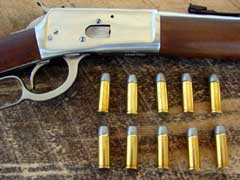
Puma .480 Ruger Levergun from Legacy Sports
International.
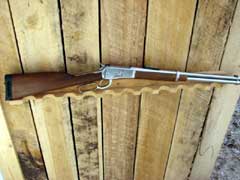
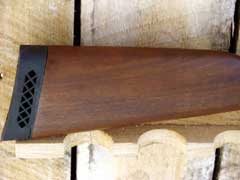
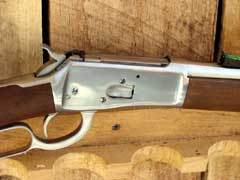
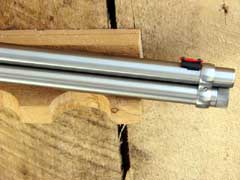
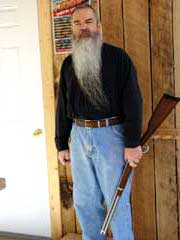
The Puma .480 is lightweight, handy and perfectly
balanced.
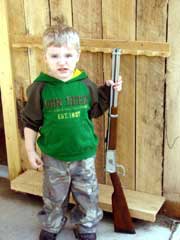
Jeff's 2-1/2 year old grandson, Ethan, shows the
compact size of the Puma.
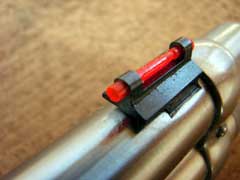
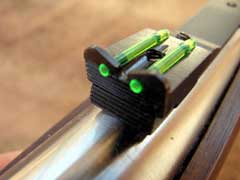
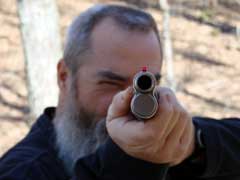
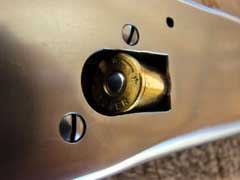
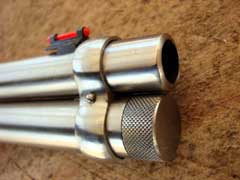
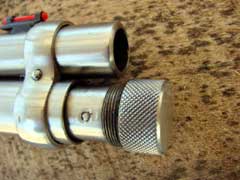
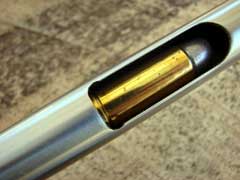
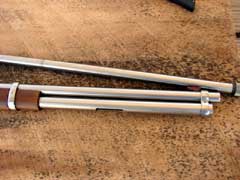

Magazine can be loaded through loading gate (top
picture) or directly into the tube like a rimfire.

Magazine tube is threaded into the receiver.

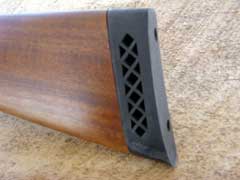
The stock features an effective recoil pad
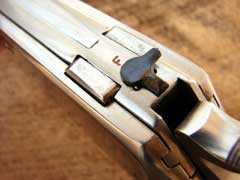
Manual safety.

The .480 Puma feeds even long and heavy bullets with
ease.
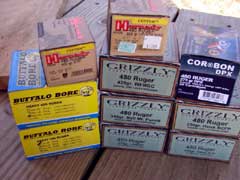
Author tested the .480 Puma with a variety of factory
loads...

...as well as handloads using (left to right):
275-grain Barnes X, 370-grain Belt Mountain Punch, 325-grain
Cast Performance Lead.
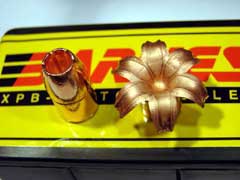
Barnes 275-grain X bullet fired into water.
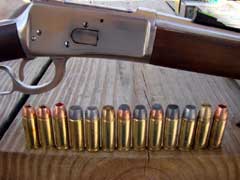
Loads tested included (left to right): Hornady 325 &
400 XTP, Cor-Bon DPX, Buffalo Bore 410 & 370 cast lead,
Grizzly 340 Punch, 350 JSP, 375 cast lead, 400 JSP, 425 cast
lead, Handloads: 325 cast lead, 370 Punch, 275 Barnes XPB.
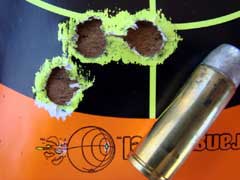
The Puma .480 is capable of fine accuracy with its issue
open sights, as shown by this 50-yard group.
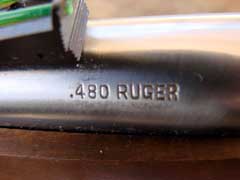
|
![]()